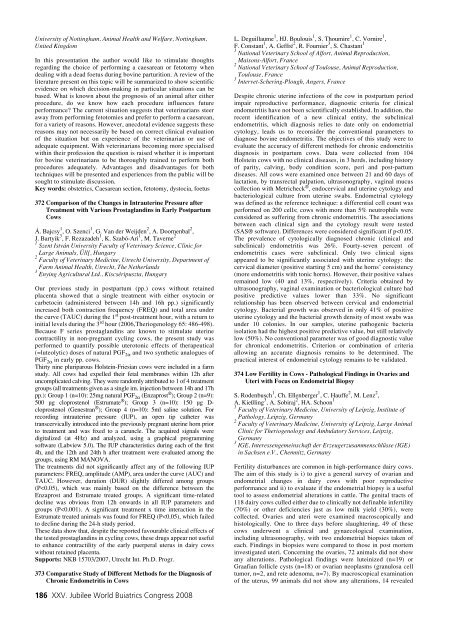Oral and Poster Abstracts
Oral and Poster Abstracts
Oral and Poster Abstracts
Create successful ePaper yourself
Turn your PDF publications into a flip-book with our unique Google optimized e-Paper software.
University of Nottingham, Animal Health <strong>and</strong> Welfare, Nottingham,<br />
United Kingdom<br />
In this presentation the author would like to stimulate thoughts<br />
regarding the choice of performing a caesarean or fetotomy when<br />
dealing with a dead foetus during bovine parturition. A review of the<br />
literature present on this topic will be summarized to show scientific<br />
evidence on which decision-making in particular situations can be<br />
based. What is known about the prognosis of an animal after either<br />
procedure, do we know how each procedure influences future<br />
performance? The current situation suggests that veterinarians steer<br />
away from performing fetotomies <strong>and</strong> prefer to perform a caesarean,<br />
for a variety of reasons. However, anecdotal evidence suggests these<br />
reasons may not necessarily be based on correct clinical evaluation<br />
of the situation but on experience of the veterinarian or use of<br />
adequate equipment. With veterinarians becoming more specialised<br />
within their profession the question is raised whether it is important<br />
for bovine veterinarians to be thoroughly trained to perform both<br />
procedures adequately. Advantages <strong>and</strong> disadvantages for both<br />
techniques will be presented <strong>and</strong> experiences from the public will be<br />
sought to stimulate discussion.<br />
Key words: obstetrics, Caesarean section, fetotomy, dystocia, foetus<br />
372 Comparison of the Changes in Intrauterine Pressure after<br />
Treatment with Various Prostagl<strong>and</strong>ins in Early Postpartum<br />
Cows<br />
Á. Bajcsy 1 , O. Szenci 1 , G. Van der Weijden 2 , A. Doornenbal 2 ,<br />
J. Bartyik 3 , F. Rezazadeh 1 , K. Szabó-Ari 1 , M. Taverne 2<br />
1 Szent István University Faculty of Veterinary Science, Clinic for<br />
Large Animals, Üll[, Hungary<br />
2 Faculty of Veterinary Medicine, Utrecht University, Department of<br />
Farm Animal Health, Utrecht, The Netherl<strong>and</strong>s<br />
3 Enying Agricultural Ltd., Kiscséripuszta, Hungary<br />
Our previous study in postpartum (pp.) cows without retained<br />
placenta showed that a single treatment with either oxytocin or<br />
carbetocin (administered between 14h <strong>and</strong> 16h pp.) significantly<br />
increased both contraction frequency (FREQ) <strong>and</strong> total area under<br />
the curve (TAUC) during the 1 st post-treatment hour, with a return to<br />
initial levels during the 3 rd hour (2006,Theriogenology 65: 486-498).<br />
Because F series prostagl<strong>and</strong>ins are known to stimulate uterine<br />
contractility in non-pregnant cycling cows, the present study was<br />
performed to quantify possible uterotonic effects of therapeutical<br />
(=luteolytic) doses of natural PGF 2a <strong>and</strong> two synthetic analogues of<br />
PGF 2a in early pp. cows.<br />
Thirty nine pluriparous Holstein-Friesian cows were included in a farm<br />
study. All cows had expelled their fetal membranes within 12h after<br />
uncomplicated calving. They were r<strong>and</strong>omly attributed to 1 of 4 treatment<br />
groups (all treatments given as a single im. injection between 14h <strong>and</strong> 17h<br />
pp.): Group 1 (n=10): 25mg natural PGF 2a (Enzaprost ® ); Group 2 (n=9):<br />
500 µg cloprostenol (Estrumate ® ); Group 3 (n=10): 150 µg Dcloprostenol<br />
(Genestran ® ); Group 4 (n=10): 5ml saline solution. For<br />
recording intrauterine pressure (IUP), an open tip catheter was<br />
transcervically introduced into the previously pregnant uterine horn prior<br />
to treatment <strong>and</strong> was fixed to a caruncle. The acquired signals were<br />
digitalized (at 4Hz) <strong>and</strong> analyzed, using a graphical programming<br />
software (Labview 5.0). The IUP characteristics during each of the first<br />
4h, <strong>and</strong> the 12th <strong>and</strong> 24th h after treatment were evaluated among the<br />
groups, using RM MANOVA.<br />
The treatments did not significantly affect any of the following IUP<br />
parameters: FREQ, amplitude (AMP), area under the curve (AUC) <strong>and</strong><br />
TAUC. However, duration (DUR) slightly differed among groups<br />
(P

















